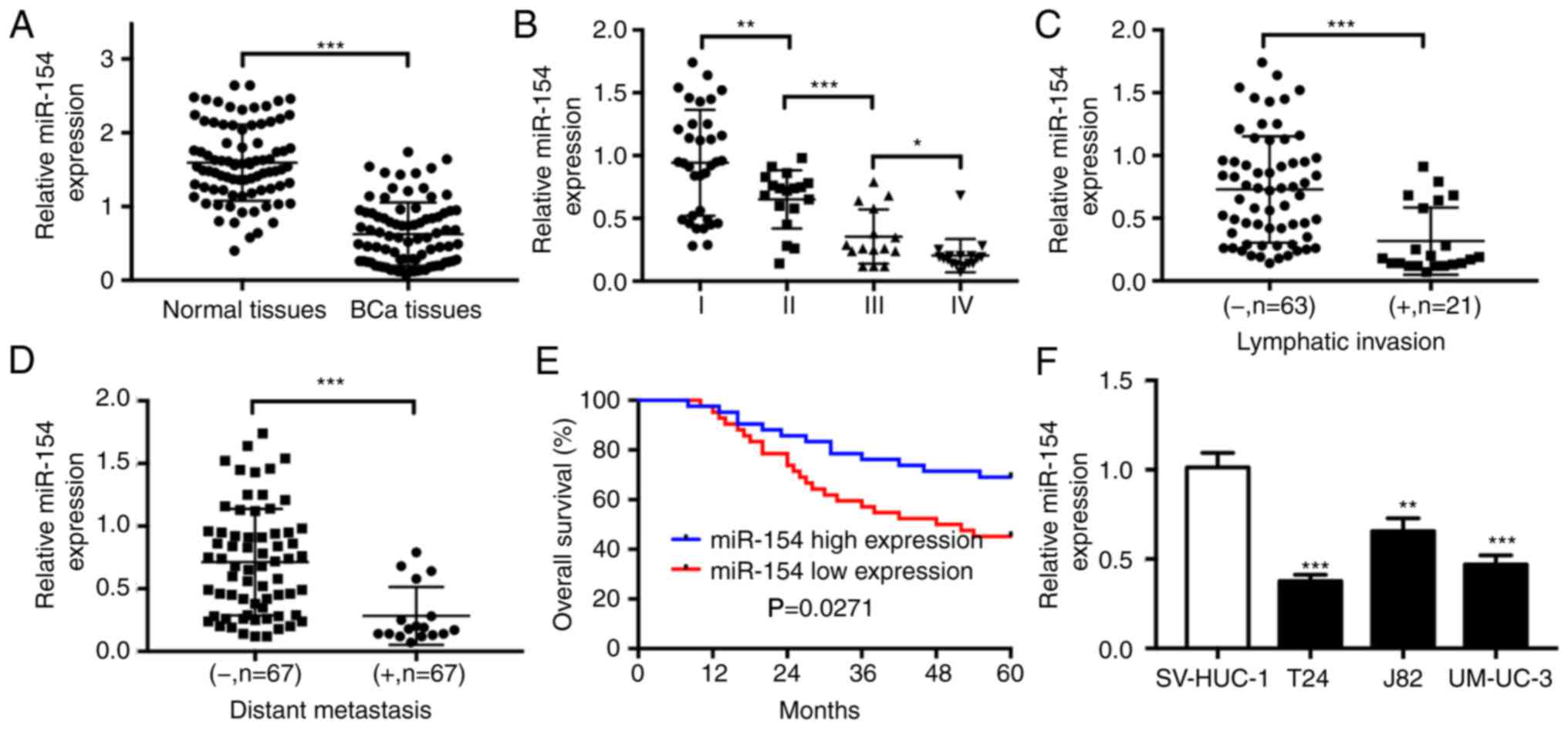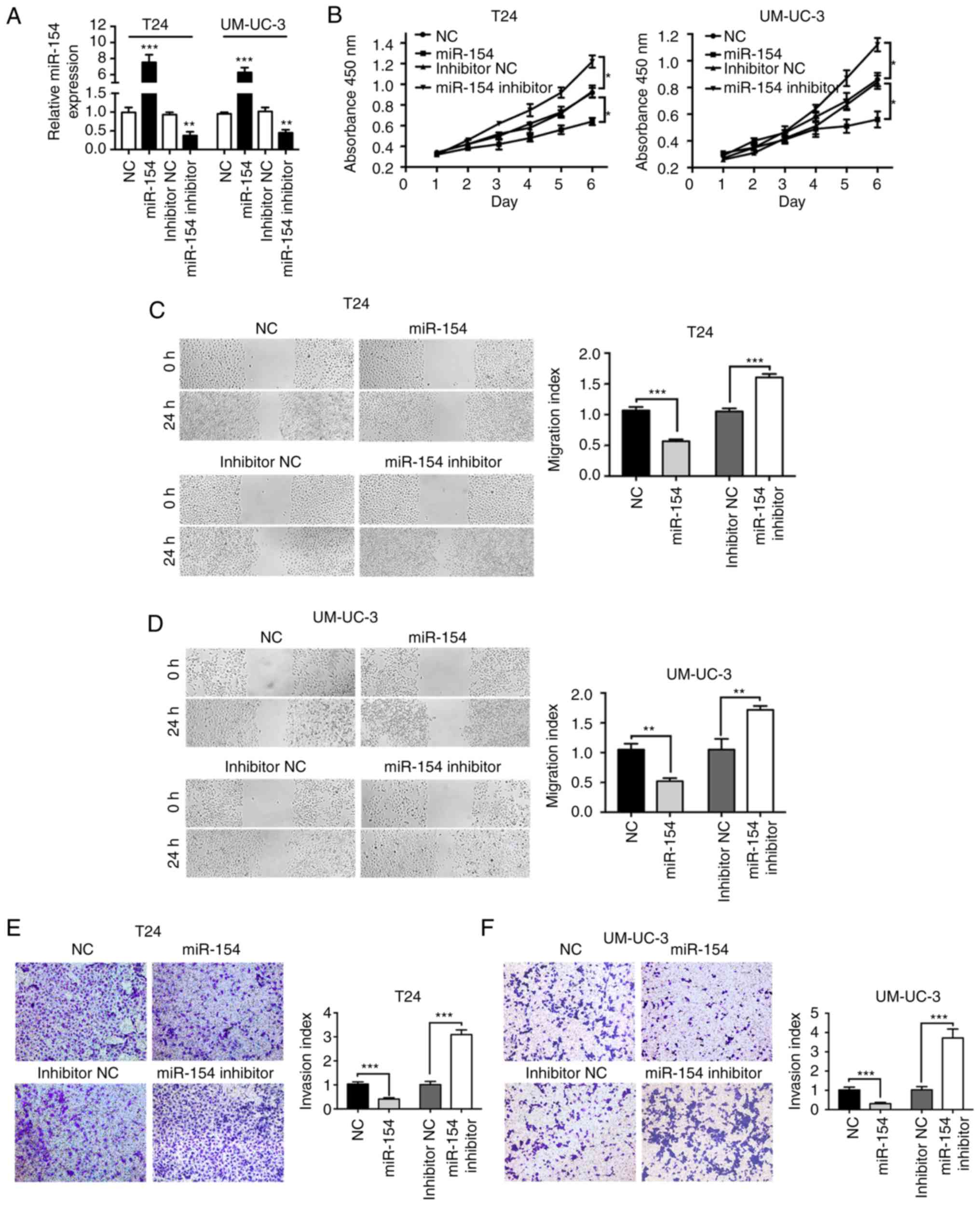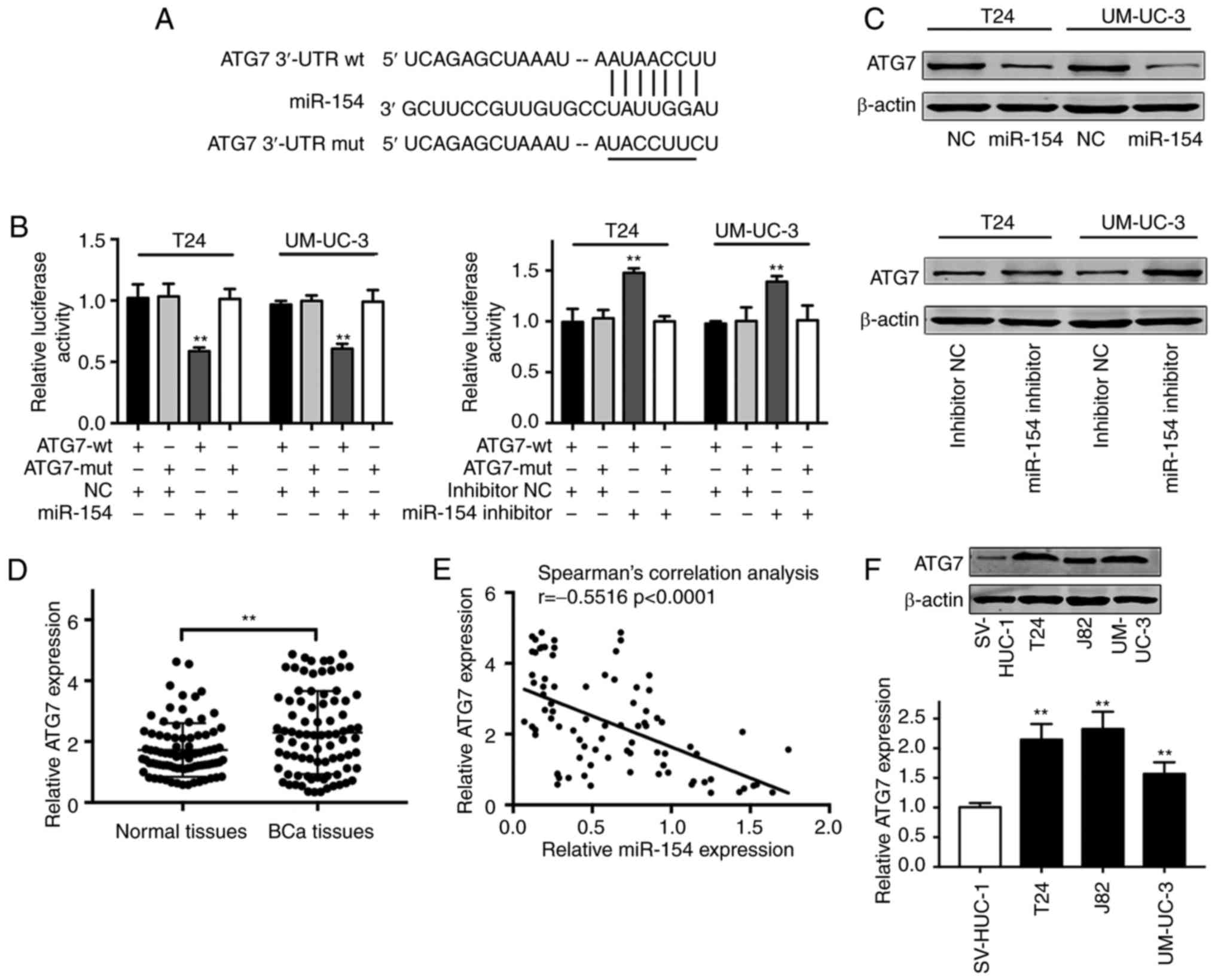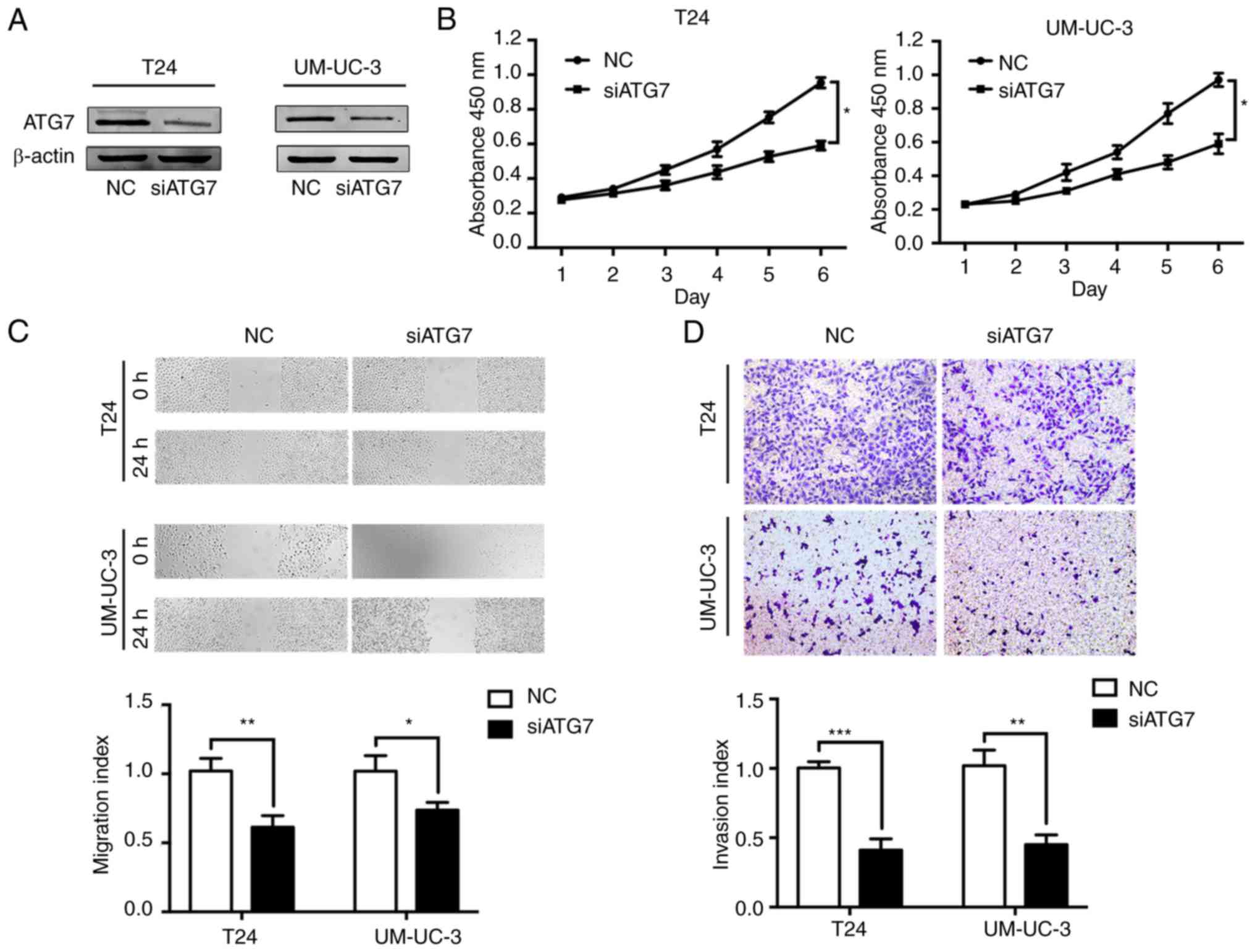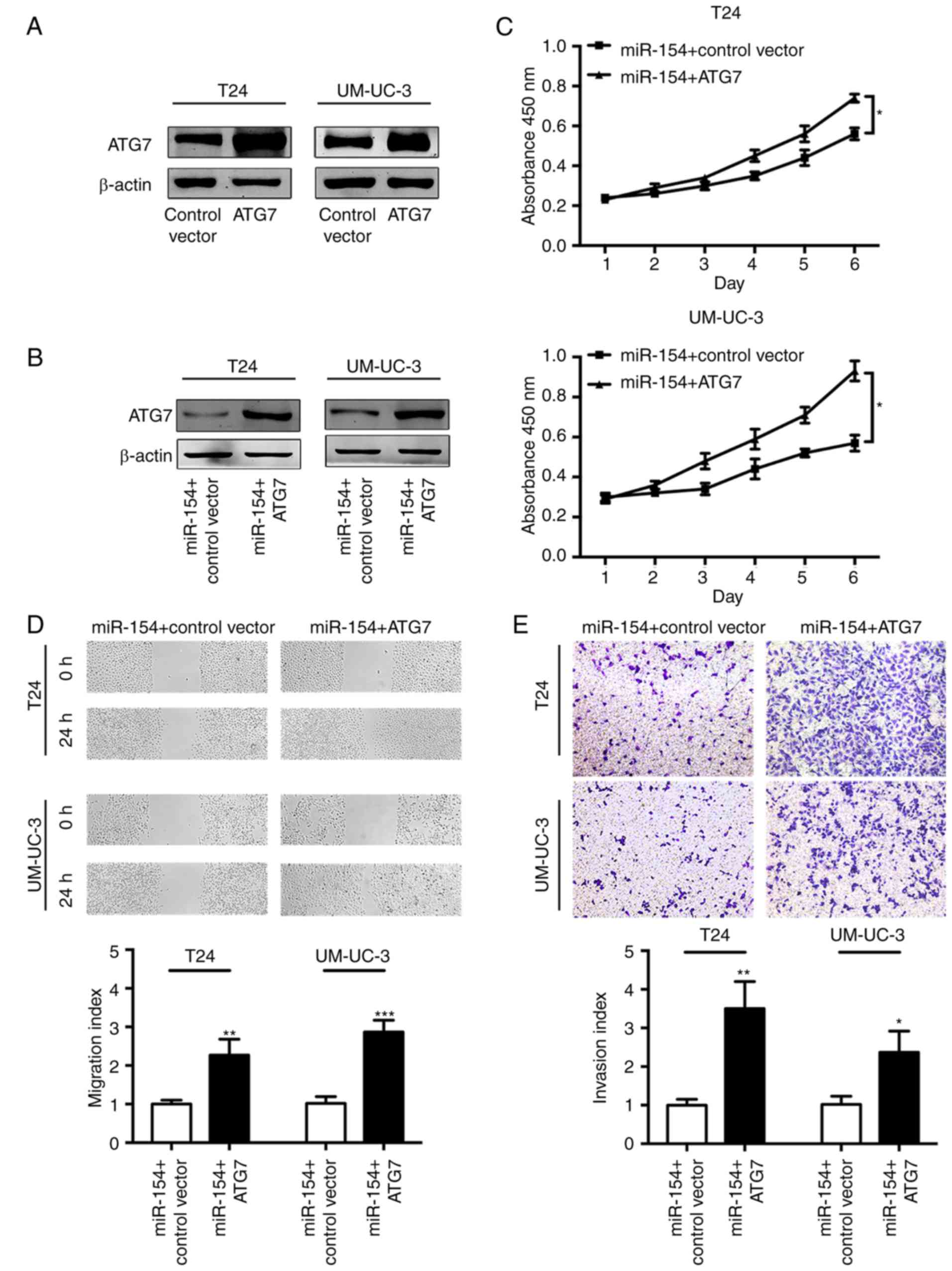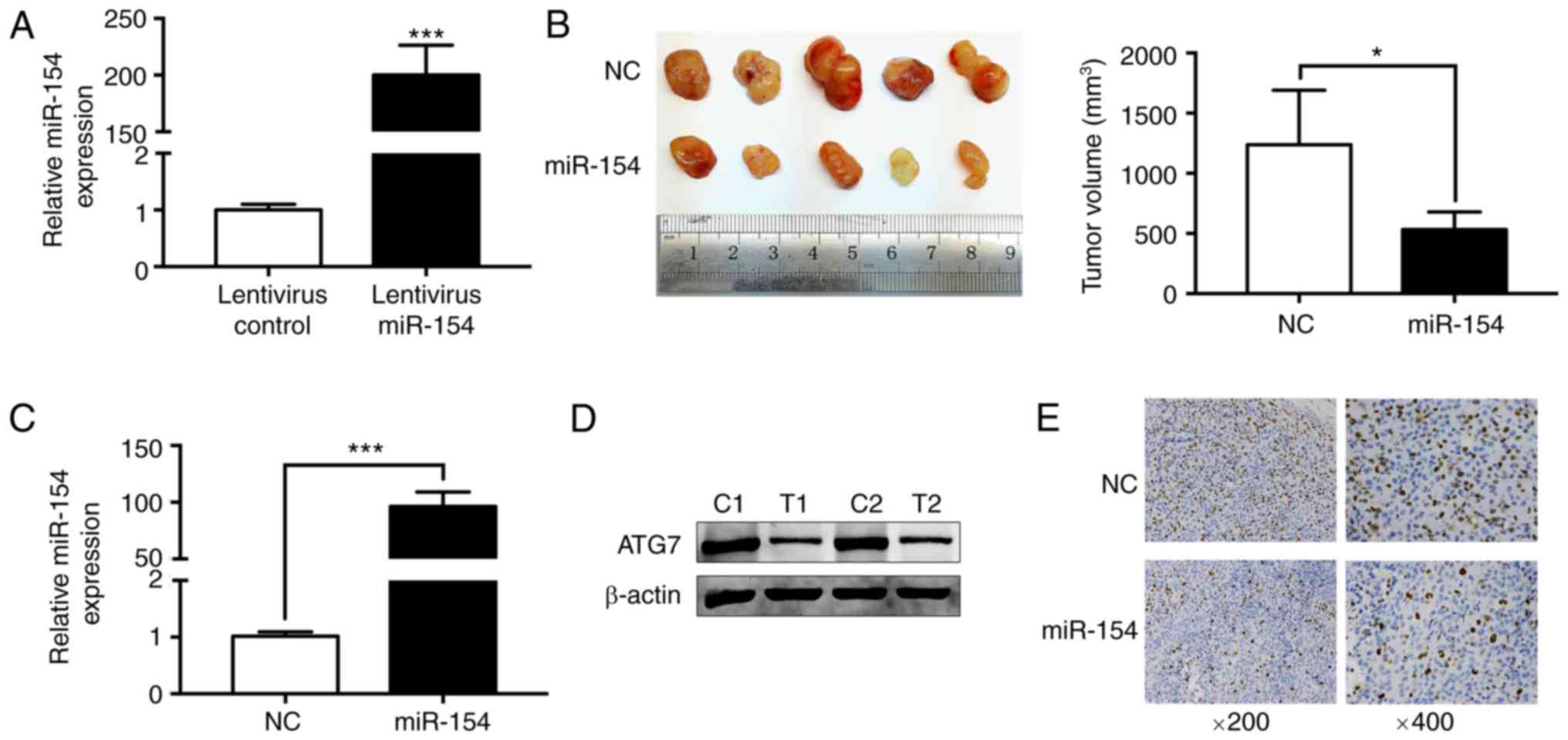MicroRNA‑154 functions as a tumor suppressor in bladder cancer by directly targeting ATG7
- Authors:
- Published online on: November 21, 2018 https://doi.org/10.3892/or.2018.6879
- Pages: 819-828
-
Copyright: © Zhang et al. This is an open access article distributed under the terms of Creative Commons Attribution License.
Abstract
Introduction
Bladder cancer (BCa) is the most common urogenital malignant tumor and its incidence is increasing worldwide (1). Despite the advances in diagnostic approach and treatment strategies, the prognosis of patients with advanced BCa remains poor (2). Therefore, further investigations of the molecular mechanisms involved in the pathogenesis of BCa and identification of potential therapeutic targets is imperative.
MicroRNAs (miRNAs) are noncoding small RNA molecules that post-transcriptionally negatively modulate protein expression via binding to the 3′-UTR of the target genes (3). miRNAs play a critical role in biological processes, including cell growth, apoptosis, differentiation, motility and malignant transformation (4,5). In addition, miRNAs can inhibit or enhance the expression of oncogenes or tumor suppressor genes, and thereby markedly affect the biology of cancer (6,7). For example, miR-145 (8), miR-122 (9) and miR-31 (10) have been revealed to influence tumorigenesis, tumor proliferation, invasion and metastasis. Several studies have also revealed that miR-154 acts as a tumor suppressor in a wide variety of human cancers, including prostate (11), colorectal (12), breast (13), liver (14) and BCa (15). However, the role of miR-154 in BCa progression has not yet been fully elucidated.
ATG7 (autophagy-related gene 7), an E1-like activating enzyme, is essential for the autophagy conjugation system and autophagosome formation (16,17). A previous study revealed that ATG7 was critical for sustained tumor cell proliferation and progression of lung tumors to adenomas and carcinomas (18). Consistently with this finding, ATG7 overexpression was shown to promote growth of human BCa both in vitro and in vivo through the FOXO1/p27 pathway. These findings indicated that ATG7 is important for BCa development (19). Till date, several miRNAs, including miR-520b (20), miR-7 (21), miR-375 (22) and miR-217 (23), have been confirmed to suppress cell growth and survival by targeting ATG7 in tumor cells. Thus, identification of miRNAs that target ATG7 in BCa will facilitate the development of ATG7-based therapies for BCa.
In the present study, we aimed to elucidate the role and the underlying mechanism of miR-154 in BCa. We found significant downregulation of miR-154 in BCa tissues and cell lines. We assessed the effect of miR-154 on cell proliferation, migration and invasion. Furthermore, we examined its effect on tumor growth in vivo. Our results revealed that miR-154 exerts a critical role in BCa progression and represents a potential target for BCa treatment.
Materials and methods
Cell lines and human tissues
Human BCa cell lines (J82, T24 and UM-UC-3) and human bladder urothelial cell line (SV-HUC-1) were purchased from the Shanghai Institute of Cell Biology at the Chinese Academy of Sciences (Shanghai, China). All cell lines were authenticated via STR profiling before running the experiments. The cells were maintained in RPMI-1640 medium supplemented with 10% fetal bovine serum (FBS; Gibco; Thermo Fisher Scientific, Inc., Waltham, MA, USA) in a humidified atmosphere with 5% CO2 at 37°C. The BCa specimens and paired adjacent non-tumor bladder urothelial tissues were obtained between January 2010 and December 2016 from patients undergoing a surgical procedure at the Shanghai Tenth People's Hospital of Tongji University, School of Medicine (Shanghai, China) and immediately frozen in liquid nitrogen. All patients provided written consent. The study was approved by the Ethics Committee of Tongji University and the BCa diagnosis was based on hematoxylin and eosin and immunohistochemical staining of tumor tissue sections. None of these patients had received any preoperative chemotherapy or radiotherapy.
Overexpression or knockdown of miR-154
The miR-154 mimics (named miR-154) and the negative control (named NC) were used for transient gain-of-function study. The miR-154 inhibitor oligo (named miR-154 inhibitor) and inhibitor negative control oligo (named inhibitor NC) were used for transient loss-of-function study. All the aforementioned products were purchased from Shanghai GenePharma Co., Ltd. (Shanghai, China). T24 and UM-UC-3 cells were seeded into 6-well plates in RPMI-1640 media supplemented with 10% FBS. At 70% confluence, the cells were transfected with Lipofectamine 3000 (Invitrogen; Thermo Fisher Scientific, Inc.) according to the manufacturer's instructions. The cells were harvested 48 h after transfection and subjected to analysis by qRT-PCR or western blotting.
Plasmid construction and siRNA interference assay
The ATG7-coding sequence without the 3′-UTR was cloned and inserted into the pcDNA3.1 vector by Sangon Biotech Co., Ltd. (Shanghai, China). An empty pcDNA3.1(+) served as the negative control. Three siRNA sequences that targeted different sites of the human ATG7 cDNA (siATG7) were designed and synthesized by Sangon Biotech Co., Ltd. A scrambled siRNA that did not target the human ATG7 cDNA was synthesized and used as a negative control. The siRNA sequences were as follows: siATG7 #1, 5′-GCCGUGGAAUUGAUGGUAU-3′ (sense); siATG7 #2, 5′-GGAUCCUGGACUCUCUAAA-3′ (sense); and siATG7 #3, 5′-GAAGCUCCCAAGGACAUUA-3′ (sense). Either the ATG7 overexpression plasmid or the ATG7 siRNAs were transfected into the T24 and UM-UC-3 cells using Lipofectamine 3000 reagent (Invitrogen; Thermo Fisher Scientific, Inc.). Total RNA and protein were isolated 24 h post-transfection. The ATG7 protein expression levels were assessed by western blotting. The siRNA sequence with the maximal interfering effect (siATG7 #1) was selected and used for all the subsequent experiments.
Total RNA extraction and quantitative real-time PCR
Total RNA was extracted from frozen tissues and cultured cells using TRIzol reagent (Invitrogen; Thermo Fisher Scientific, Inc.) according to the manufacturer's protocol. The concentration and purity of RNA were determined by ND-2000 Spectrophotometer (Thermo Fisher Scientific, Inc.). For miR-154 detection, cDNA was synthesized using 1 µg of total RNA by One Step PrimeScript miRNA cDNA Synthesis kit (Qiagen, Inc., Valencia, CA, USA). Quantitative real-time PCR (qRT-PCR) assay was performed using KAPA SYBR FAST qPCR Kit (Kapa Biosystems, Inc., Wilmington, MA, USA). The amplification procedure was as follows: 5 min at 95°C, followed by 40 cycles at 95°C for 30 sec and 65°C for 45 sec. The expression of miR-154 was normalized to that of U6. To determine the mRNA level of ATG7, cDNA was synthesized using PrimeScript RT Reagent kit (Takara Bio, Inc., Otsu, Japan) according to the manufacturer's instructions. The mRNA expression level of ATG7 was normalized to that of β-actin (Sangon Biotech Co., Ltd). qRT-PCR was performed using KAPA SYBR FAST qPCR kit (Kapa Biosystems, Inc.). The primers for qRT-PCR analysis were as follows: miR-154 forward, 5′-TAGGTTATCCGTGTTG-3′ and reverse, 5′-ATCCAGTGCAGGGTCCGAGG-3′; U6 forward, 5′-TGCGGGTGCTCGCTTCGCAGC-3′ and reverse, 5′-CCAGTGCAGGGTCCGAGGT-3′; ATG7 forward, 5′-GCTTCCGTGACCGTACCATG-3′ and reverse, 5′-TCCATACATTCACTGAGGTTCACCATC-3′; β-actin forward, 5′-CCTGGCACCCAGCACAAT-3′ and reverse, 5′-GGGCCGGACTCGTCATAC-3′. The PCR parameters for relative quantification were as follows: 2 min at 95°C, followed by 40 cycles of 45 sec at 57°C and 45 sec at 72°C. The relative expression of miR-154 and ATG7 were calculated using the 2−ΔΔCq method (24).
Western blotting
The total protein of cells and tissues was extracted in RIPA buffer (Beyotime Institute of Biotechnology, Shanghai, China) supplemented with 1% protease inhibitor cocktail (Thermo Fisher Scientific, Inc.). The reaction mixture was incubated on ice for 30 min and centrifuged for 10 min at 12,000 × g at 4°C. The supernatant was collected, and the protein concentration was estimated using a Pierce BCA protein assay kit (Thermo Fisher Scientific, Inc.). Then 20 µg of protein was loaded into 12.5% SDS-PAGE gel and transferred to nitrocellulose membranes. The membranes were blocked in 5% non-fat milk for 1 h and then incubated with primary antibodies: Anti-ATG7 (dilution 1:50,000; cat. no. ab52472; Abcam, Cambridge, MA, USA) and anti-β-actin (dilution 1:2,000; Santa Cruz Biotechnology, Inc., Santa Cruz, CA, USA) overnight at 4°C. After washing with PBST three times, the membranes were incubated with the corresponding secondary antibodies at room temperature for 1 h. The protein band was visualized using the Odyssey scanner (LI-COR Biosciences, Lincoln, NE, USA).
Cell proliferation assay
Cell proliferation was assessed using Cell Counting Kit-8 (CCK-8; Dojindo Molecular Technologies, Inc., Kumamoto, Japan). The transfected cells were seeded into 96-well plates at a density of 1,000 cells/well. Then, 10 µl CCK-8 reagent was added to each plate at selected time-points and incubated for 2 h at 37°C. The absorbance was measured at 450 nm with a microplate spectrophotometer (BioTek, Instruments, Inc., Winooski, VT, USA).
Wound healing and Transwell assays
Wound healing assays were performed to detect the migration capacity of the cells. The transfected cells were seeded into 6-well plates and cultured until 80% confluence was achieved. A sterile 200-µl pipette tip was used to scratch the monolayer in each well. The wound closure was observed and images were captured at 24 h after making the wound and compared with the 0-h images. Transwell assays were performed using Transwell chambers (Corning Inc., Corning, NY, USA) coated with Matrigel (BD Biosciences, San Jose, CA, USA) on the upper surface. Briefly, 3×104 cells were seeded in the upper chambers in serum-free medium. The lower chambers were filled with RPMI-1640 medium supplemented with 10% FBS. After incubation at 37°C for 24 h, the cells on the lower membrane were fixed with 75% ethanol for 20 min and stained with 0.1% crystal violet. Five visual fields (×100 magnification) were selected randomly, and invaded cells were counted and imaged under a light microscope (Olympus Corp., Tokyo, Japan).
Tumor formation in nude mice
A lentiviral vector that overexpressed miR-154 was purchased. (Invitrogen; Thermo Fisher Scientific, Inc.). T24 cells were transduced with the lentiviruses and stable clones were selected with puromycin for 2 weeks according to the manufacturer's instructions. Cells were then harvested for animal experiments. Ten 4-week-old male BALB/c nude mice were purchased from Shanghai Experimental Animal Center, Chinese Academy of Sciences (Shanghai, China). The mice were maintained under a 12-h dark/light cycle with ad libitum access to food in specific pathogen-free conditions (55% humidity and 22°C). The mice were randomly divided into two groups (5 per group) and subcutaneously injected with T24 cells (2×106 cells/mouse) that were infected with either control lentivirus or a lentivirus that overexpressed miR-154. The tumor volume was calculated by the following formula: Tumor volume (mm3) = [length (mm)] × [width (mm)]2 × 0.5. To determine the proliferation of the cells, Ki-67 staining of tumor tissues obtained from xenograft mice was performed as previously described (25). The mice were sacrificed by cervical dislocation after 28 days. All animal studies were approved by the Institutional Animal Care and Use Committee of the Shanghai Tenth People's Hospital (Shanghai, China).
Dual-Luciferase reporter assay
The target genes were predicted using bioinformatics analysis tools, including TargetScan (http://www.targetscan.org/vert_72/), ComiR (http://www.benoslab.pitt.edu/comir/) and miRANDA (http://www.microrna.org/). To confirm the presence of miR-154 binding sites in the ATG7 3′-UTR, ATG7-wild-type 3′-UTR (ATG7-wt) and ATG7-mutant 3′-UTR (ATG7-mut) luciferase psiCHECK-2 reporter vectors were constructed. For the luciferase assay, T24 and UM-UC-3 cells were plated into 24-well plates and co-transfected with 100 ng luciferase psiCHECK-2 reporter vectors and miR-154/miR-154 inhibitor or negative control. All plasmid vectors were purchased from Promega Corp. (Madison, WI, USA). After 48 h of incubation the luciferase activity was assessed using a Luciferase Reporter Assay System (Promega Corp.), according to the manufacturer's instructions.
Statistical analysis
Data were analyzed using SPSS 15.0 software (SPSS, Inc., Chicago, IL, USA). Results are presented as the mean ± standard deviation (SD) from at least three independent experiments. The Student's t-test was used to assess between-group differences, and one-way analysis of variance (ANOVA) plus post hoc Bonferroni test was used when comparing more than two groups. The association between the characteristics of patients and miR-154 expression was evaluated by Chi-square test or Fisher's exact test. The relationship between ATG7 and miR-154 expression was quantified using Spearman's correlation. Survival analysis was performed by Kaplan-Meier method and log-rank t-test. P-values <0.05 were considered to indicate a statistically significant difference.
Results
miR-154 is downregulated in BCa
By utilizing real-time PCR, the expression of miR-154 in 84 BCa tissue samples was found to be significantly decreased in comparison with the corresponding adjacent normal bladder urothelial tissues (Fig. 1A). Next, the 84 clinical samples were divided into two groups according to the median relative expression levels of miR-154. The correlation between miR-154 levels and clinicopathological features of BCa is summarized in Table I. miR-154 expression was significantly related with T stage (P=0.008), lymphatic invasion (P=0.023) and distant metastasis (P=0.015). The results revealed a gradual decrease in miR-154 levels with progression of T stage (Fig. 1B). In addition, miR-154 expression in BCa tissues with lymphatic invasion was significantly downregulated when compared to that in tissues without lymphatic invasion (Fig. 1C). Further analysis revealed that miR-154 expression was also significantly decreased in metastatic BCa tissues (Fig. 1D). We further evaluated the impact of miR-154 on the survival outcomes of BCa patients. The overall survival (OS) of patients with low miR-154 expression was poorer than that of patients with high miR-154 expression (Fig. 1E). Next, we also detected significant downregulation of miR-154 in BCa cell lines compared with the human bladder urothelial cell line SV-HUC-1 (Fig. 1F). Collectively, these data confirmed the low expression level of miR-154 in BCa tissues and cell lines.
miR-154 suppresses BCa cell proliferation, migration, and invasion in vitro
Owing to the marked downregulation of miR-154 in human BCa tissues and cells, miR-154 may function as a putative tumor suppressor in BCa. To study the tumor suppressive role of miR-154 in BCa, we examined the proliferation, migration and invasion of transfected BCa cells. First, the mRNA expression level of miR-154 was assessed by qRT-PCR (Fig. 2A). When compared to the group transfected with the negative control, T24 and UM-UC-3 cells transfected with miR-154 mimics exhibited a significantly reduced proliferation ability (Fig. 2B). The opposite effect was observed in BCa cells transfected with miR-154 inhibitor (Fig. 2B). The effect of miR-154 on the migration and invasion of BCa cells was next assessed. Wound healing assays revealed that T24 and UM-UC-3 cells transfected with miR-154 mimics exhibited a slower recovery capacity when compared to the control cells; however, decreased miR-154 levels in BCa cells transfected with the miR-154 inhibitor led to faster wound closure when compared to the control cells (Fig. 2C and D). Transwell assays revealed a similar result in that miR-154 overexpression inhibited invasion, and decreased miR-154 levels accelerated the invasion of T24 and UM-UC-3 cells (Fig. 2E and F). Collectively, these results indicated that miR-154 suppressed the biological behavior of BCa in vitro.
miR-154 directly targets ATG7
To explore the potential mechanisms that underlie the miR-154-mediated BCa cell biological behaviors, three common bioinformatic databases (TargetScan, ComiR and miRANDA) were used to predict the mRNA targets of miR-154. ATG7 gene was selected as a potential target of miR-154 (Fig. 3A). We conducted a luciferase reporter assay to determine whether
ATG7 was regulated by miR-154 in BCa cells
The results revealed that miR-154 overexpression by mimics significantly inhibited and miR-154 inhibitor significantly increased the reporter activity of the wild-type ATG7 3′-UTR but not that of the mutant ATG7 3′-UTR (Fig. 3B). Western blot analysis demonstrated that miR-154 mimics significantly inhibited, while the miR-154 inhibitor increased the endogenous ATG7 protein expression in both T24 and UM-UC-3 cells (Fig. 3C).
To assess the potential association between the expressions of ATG7 and miR-154 in BCa, the expression of ATG7 was investigated in the same pairs of BCa tissues. The results revealed that ATG7 expression was generally higher in BCa tissues (Fig. 3D). Further analysis revealed a strong inverse correlation between miR-154 and ATG7 in BCa tissues (Fig. 3E; P<0.0001, r=−0.5516). Additionally, the results of qRT-PCR assays and western blotting revealed a higher expression of ATG7 in BCa cell lines when compared to that in SV-HUC-1 cells (Fig. 3F).
ATG7 functions to suppress BCa
It was hypothesized that ATG7 may act as the vital effector of miR-154 in the progression of BCa. To determine whether ATG7 was involved in miR-154-suppressed BCa progression, ATG7 was knocked down by siRNA (siATG7) in T24 and UM-UC-3 cell lines (Fig. 4A) and BCa cellular functions were monitored. The results of CCK-8 assays revealed that the proliferation capacity of BCa cells was significantly inhibited after treatment with siATG7 (Fig. 4B). Similarly, the BCa cells with lower ATG7 expression exhibited suppressed cell migration and invasion capacities (Fig. 4C and D). Collectively, consistent with miR-154, siATG7 suppressed BCa progression by inhibiting tumor cell proliferation, migration, and invasion.
To better understand the reliance of miR-154 on ATG7 for modulation of the biological behavior of BCa cells, we overexpressed ATG7 in BCa cells (Fig. 5A). The transfection of the ATG7 overexpression vector restored ATG7 protein levels when compared to the control group of BCa cells pretreated with the miR-154 mimics (Fig. 5B). Notably, subsequent CCK-8 assays revealed that reintroducing ATG7 restored the miR-154-mediated growth suppression of BCa cells (Fig. 5C). Likewise, the suppressive effect of miR-154 on BCa cell migration and invasion could be reversed by reconstitution of ATG7 (Fig. 5D and E). Collectively, these findings implied that miR-154 partially suppressed the progression of BCa cells by inhibiting ATG7.
miR-154 inhibits BCa proliferation and tumorigenesis in vivo
BCa xenograft mouse models were then used to determine the function of miR-154 in vivo. The miR-154 levels in the stably transfected cell line was 200-fold higher than that in the control cell line (Fig. 6A). Consistent with the in vitro findings, the overexpression of miR-154 caused significant inhibition of tumor growth in vivo (Fig. 6B). The miR-154 level in the xenograft tumor tissues was 100-fold higher than that in the control group (Fig. 6C). Furthermore, the miR-154-overexpressed group revealed low ATG7 levels when compared to that in the control group (Fig. 6D). In addition, Ki-67 staining revealed less proliferation in the miR-154 group (Fig. 6E). Collectively, the results indicated a critical role of miR-154 in suppressing BCa growth in vivo.
Discussion
Emerging evidence suggests that miRNAs play a critical role in carcinogenesis and cancer progression (26). Therefore, a better understanding of the biological functions of miRNAs may help identify novel molecular markers for BCa and facilitate the development of novel therapeutic strategies. Aberrantly expressed miRNAs have been reported in several human cancers, including BCa (27–29). Previous studies have revealed that aberrant expression of miR-154 is involved in the initiation and tumor progression of various human cancers. Xu et al found that miR-154 was frequently downregulated in breast cancer tissues and that it functioned as a tumor suppressor in breast cancer by targeting E2F5 (13). Chen and Gao demonstrated that miR-154 inhibited the growth of skin squamous cell carcinoma cells by targeting the p53 signaling pathway (30). Additionally, miR-154 was revealed to be downregulated in human hepatocellular carcinoma tissues and to inhibit cell proliferation, migration and invasion via suppression of ZEB2 (14). However, the role of miR-154 in BCa remains unclear.
In the present study, we found marked downregulation of miR-154 in BCa tissues and cell lines, which was consistent with the results of a previous study (15). Moreover, a decreased miR-154 level was correlated with aggressive clinicopathological features, including advanced T stage, lymphatic invasion, and distant metastasis. Decreased miR-154 expression predicted unfavorable OS of BCa patients. To better characterize the role of miR-154 in BCa, functional studies were conducted. miR-154 overexpression inhibited the proliferation, migration, and invasion of BCa cells, while knockdown of miR-154 yielded the opposite effects in vitro. These findings indicated that miR-154 functioned as a tumor suppressor in BCa.
Zhao et al revealed miR-154 inhibited BC cell proliferation, migration, and invasion by regulating RSF1 and RUNX2 expression (15). Actually, it has been well established that one specific microRNA is able to target multiple downstream genes and thus determine its biological role. To explore the potential molecular mechanisms by which miR-154 functioned as a tumor suppressor in BCa, we performed bioinformatics analysis using TargetScan, ComiR, and miRANDA and predicted ATG7 as a candidate target of miR-154. Subsequently, dual luciferase reporter assays identified ATG7 as a direct target of miR-154 in BCa. ATG7, an E1-like activating enzyme, is essential for the biogenesis of autophagosomes (17). Recent studies have demonstrated that ATG7 is upregulated in some human malignancies, such as lung cancer (31), neuroblastoma (32) and BCa (19). ATG7 was reported to be upregulated in human colorectal cancer and was shown to promote the oncogenic transformation of cells with deregulated WNT/β-catenin signaling (33). In addition, Piya et al revealed that ATG7 knockdown in acute myeloid leukemia cells resulted in a proapoptotic phenotype that showed increased chemosensitivity (34). In a recent study, deletion of ATG7 was revealed to suppress a carcinogen-induced pro-tumorigenic inflammatory microenvironment and tumorigenesis in epithelial cells (35). All these findings indicated that ATG7 is an important oncogene. In the present study, western blot analysis demonstrated that the expression level of ATG7 in T24 and UM-UC-3 cells transfected with miR-154 mimics was significantly lower than that in the negative control. Additionally, ATG7 was significantly increased in BCa tissues and cell lines. Further analysis revealed a strong inverse correlation between miR-154 and ATG7 in BCa tissues. Based on these results, we hypothesized that miR-154-mediated ATG7 inhibition is a promising potential therapeutic option for BCa.
Furthermore, ATG7-siRNA knockdown inhibited the proliferation, migration, and invasion ability of BCa cells, which was similar to the effects of miR-154 overexpression. Notably, we further observed that the restoration of ATG7 expression successfully attenuated the inhibitory effects of miR-154 on BCa cell proliferation, migration, and invasion. Collectively, these findings indicated that the tumor-suppressive effects of miR-154 may be mediated via downregulation of ATG7 in BCa cells. Future research is required to understand the precise mechanism of action of the miR-154/ATG7 pathway and its role in regulating other signaling pathways in BCa.
To summarize, our data supports the assumption that miR-154 may function as a tumor suppressor in BCa by attenuating the expression of ATG7. These findings improved our understanding of the molecular mechanisms that underlie BCa and provide novel therapeutic targets.
Acknowledgements
The authors would like to thank the personnel of the Central Laboratory of the Shanghai Tenth People's Hospital for their assistance and support.
Funding
The present study was supported by the National Natural Science Foundation of China (nos. 81472389 and 81272836).
Availability of data and materials
The analyzed datasets generated during the study are available from the corresponding author on reasonable request.
Authors' contributions
JZ, FY and XY made substantial contributions to the conception and design of the study; JZ and FY drafted the manuscript; JZ, FY and XY made substantial contributions to the acquisition, analysis and interpretation of the data for the study; SM, LW, WZ, ZZ, YW and YG contributed to the acquisition and analysis of the data for the study; JZ, FY and XY revised the manuscript critically for important intellectual content. All authors gave the final approval of the manuscript to be published and agree to be accountable for all aspects of the study in ensuring that questions related to the accuracy or integrity of any part of the study are appropriately investigated and resolved.
Ethics approval and consent to participate
The patient study was approved by the Ethics Committee of Shanghai Tenth People's Hospital of Tongji University (Inner Mongolia, China). Informed consent was obtained from all patients or their relatives. The animal experiments were approved by the Animal Care and Use Committee of Tongji University (Inner Mongolia, China).
Patient consent for publication
Not applicable.
Competing interests
The authors declare that they have no competing interests.
References
|
Kamat AM, Hahn NM, Efstathiou JA, Lerner SP, Malmstrom PU, Choi W, Guo CC, Lotan Y and Kassouf W: Bladder cancer. Lancet. 388:2796–2810. 2016. View Article : Google Scholar : PubMed/NCBI | |
|
Antoni S, Ferlay J, Soerjomataram I, Znaor A, Jemal A and Bray F: Bladder cancer incidence and mortality: A global overview and recent trends. Eur Urol. 71:96–108. 2017. View Article : Google Scholar : PubMed/NCBI | |
|
Bartel DP: MicroRNAs: Target recognition and regulatory functions. Cell. 136:215–233. 2009. View Article : Google Scholar : PubMed/NCBI | |
|
Babashah S and Soleimani M: The oncogenic and tumour suppressive roles of microRNAs in cancer and apoptosis. Eur J Cancer. 47:1127–1137. 2011. View Article : Google Scholar : PubMed/NCBI | |
|
Robb T, Reid G and Blenkiron C: Exploiting microRNAs As cancer therapeutics. Target Oncol. 12:163–178. 2017. View Article : Google Scholar : PubMed/NCBI | |
|
Gandellini P, Doldi V and Zaffaroni N: microRNAs as players and signals in the metastatic cascade: Implications for the development of novel anti-metastatic therapies. Semin Cancer Biol. 44:132–140. 2017. View Article : Google Scholar : PubMed/NCBI | |
|
Wong CM, Tsang FH and Ng IO: Non-coding RNAs in hepatocellular carcinoma: Molecular functions and pathological implications. Nat Rev Gastroenterol Hepatol. 15:137–151. 2018. View Article : Google Scholar : PubMed/NCBI | |
|
Sathyanarayanan A, Chandrasekaran KS and Karunagaran D: microRNA-145 downregulates SIP1-expression but differentially regulates proliferation, migration, invasion and Wnt signaling in SW480 and SW620 cells. J Cell Biochem. 119:2022–2035. 2018. View Article : Google Scholar : PubMed/NCBI | |
|
Fan Y, Ma X, Li H, Gao Y, Huang Q, Zhang Y, Bao X, Du Q, Luo G, Liu K, et al: miR-122 promotes metastasis of clear-cell renal cell carcinoma by downregulating Dicer. Int J Cancer. 142:547–560. 2018. View Article : Google Scholar : PubMed/NCBI | |
|
Lv C, Li F, Li X, Tian Y, Zhang Y, Sheng X, Song Y, Meng Q, Yuan S, Luan L, et al: MiR-31 promotes mammary stem cell expansion and breast tumorigenesis by suppressing Wnt signaling antagonists. Nat Commun. 8:10362017. View Article : Google Scholar : PubMed/NCBI | |
|
Formosa A, Markert EK, Lena AM, Italiano D, Finazzi-Agro E, Levine AJ, Bernardini S, Garabadgiu AV, Melino G and Candi E: MicroRNAs, miR-154, miR-299-5p, miR-376a, miR-376c, miR-377, miR-381, miR-487b, miR-485-3p, miR-495 and miR-654-3p, mapped to the 14q32.31 locus, regulate proliferation, apoptosis, migration and invasion in metastatic prostate cancer cells. Oncogene. 33:5173–5182. 2014. View Article : Google Scholar : PubMed/NCBI | |
|
Xin C, Zhang H and Liu Z: miR-154 suppresses colorectal cancer cell growth and motility by targeting TLR2. Mol Cell Biochem. 387:271–277. 2014. View Article : Google Scholar : PubMed/NCBI | |
|
Xu H, Fei D, Zong S and Fan Z: MicroRNA-154 inhibits growth and invasion of breast cancer cells through targeting E2F5. Am J Transl Res. 8:2620–2630. 2016.PubMed/NCBI | |
|
Pang X, Huang K, Zhang Q, Zhang Y and Niu J: miR-154 targeting ZEB2 in hepatocellular carcinoma functions as a potential tumor suppressor. Oncol Rep. 34:3272–3279. 2015. View Article : Google Scholar : PubMed/NCBI | |
|
Zhao X, Ji Z, Xie Y, Liu G and Li H: MicroRNA-154 as a prognostic factor in bladder cancer inhibits cellular malignancy by targeting RSF1 and RUNX2. Oncol Rep. 38:2727–2734. 2017. View Article : Google Scholar : PubMed/NCBI | |
|
Karvela M, Baquero P, Kuntz EM, Mukhopadhyay A, Mitchell R, Allan EK, Chan E, Kranc KR, Calabretta B, Salomoni P, et al: ATG7 regulates energy metabolism, differentiation and survival of Philadelphia-chromosome-positive cells. Autophagy. 12:936–948. 2016. View Article : Google Scholar : PubMed/NCBI | |
|
Kimmelman AC and White E: Autophagy and tumor metabolism. Cell Metab. 25:1037–1043. 2017. View Article : Google Scholar : PubMed/NCBI | |
|
Guo JY, Karsli-Uzunbas G, Mathew R, Aisner SC, Kamphorst JJ, Strohecker AM, Chen G, Price S, Lu W, Teng X, et al: Autophagy suppresses progression of K-ras-induced lung tumors to oncocytomas and maintains lipid homeostasis. Genes Dev. 27:1447–1461. 2013. View Article : Google Scholar : PubMed/NCBI | |
|
Zhu J, Li Y, Tian Z, Hua X, Gu J, Li J, Liu C, Jin H, Wang Y, Jiang G, et al: ATG7 overexpression is crucial for tumorigenic growth of bladder cancer in vitro and in vivo by targeting the ETS2/miRNA196b/FOXO1/p27 Axis. Mol Ther Nucleic Acids. 7:299–313. 2017. View Article : Google Scholar : PubMed/NCBI | |
|
Gao AM, Zhang XY, Hu JN and Ke ZP: Apigenin sensitizes hepatocellular carcinoma cells to doxorubic through regulating miR-520b/ATG7 axis. Chem Biol Interact. 280:45–50. 2018. View Article : Google Scholar : PubMed/NCBI | |
|
Gu DN, Jiang MJ, Mei Z, Dai JJ, Dai CY, Fang C, Huang Q and Tian L: microRNA-7 impairs autophagy-derived pools of glucose to suppress pancreatic cancer progression. Cancer Lett. 400:69–78. 2017. View Article : Google Scholar : PubMed/NCBI | |
|
Chang Y, Yan W, He X, Zhang L, Li C, Huang H, Nace G, Geller DA, Lin J and Tsung A: miR-375 inhibits autophagy and reduces viability of hepatocellular carcinoma cells under hypoxic conditions. Gastroenterology. 143:177–187.e8. 2012. View Article : Google Scholar : PubMed/NCBI | |
|
Zeng Y, Huo G, Mo Y, Wang W and Chen H: MIR137 regulates starvation-induced autophagy by targeting ATG7. J Mol Neurosci. 56:815–821. 2015. View Article : Google Scholar : PubMed/NCBI | |
|
Livak KJ and Schmittgen TD: Analysis of relative gene expression data using real-time quantitative PCR and the 2ΔΔCT method. Methods. 25:402–408. 2001. View Article : Google Scholar : PubMed/NCBI | |
|
Margulis V, Shariat SF, Ashfaq R, Sagalowsky AI and Lotan Y: Ki-67 is an independent predictor of bladder cancer outcome in patients treated with radical cystectomy for organ-confined disease. Clin Cancer Res. 12:7369–7373. 2006. View Article : Google Scholar : PubMed/NCBI | |
|
Rupaimoole R and Slack FJ: MicroRNA therapeutics: Towards a new era for the management of cancer and other diseases. Nat Rev Drug Discov. 16:203–222. 2017. View Article : Google Scholar : PubMed/NCBI | |
|
Wang W, Zhao E, Yu Y, Geng B, Zhang W and Li X: MiR-216a exerts tumor-suppressing functions in renal cell carcinoma by targeting TLR4. Am J Cancer Res. 8:476–488. 2018.PubMed/NCBI | |
|
Xu M, Li J, Wang X, Meng S, Shen J, Wang S, Xu X, Xie B, Liu B and Xie L: MiR-22 suppresses epithelial-mesenchymal transition in bladder cancer by inhibiting Snail and MAPK1/Slug/vimentin feedback loop. Cell Death Dis. 9:2092018. View Article : Google Scholar : PubMed/NCBI | |
|
Juracek J, Peltanova B, Dolezel J, Fedorko M, Pacik D, Radova L, Vesela P, Svoboda M, Slaby O and Stanik M: Genome-wide identification of urinary cell-free microRNAs for non-invasive detection of bladder cancer. J Cell Mol Med. 22:2033–2038. 2018. View Article : Google Scholar : PubMed/NCBI | |
|
Chen HQ and Gao D: Inhibitory effect of microRNA-154 targeting WHSC1 on cell proliferation of human skin squamous cell carcinoma through mediating the P53 signaling pathway. Int J Biochem Cell Biol. 100:22–29. 2018. View Article : Google Scholar : PubMed/NCBI | |
|
Sun S, Wang Z, Tang F, Hu P, Yang Z, Xue C, Gong J, Shi L and Xie C: ATG7 promotes the tumorigenesis of lung cancer but might be dispensable for prognosis predication: A clinicopathologic study. Onco Targets Ther. 9:4975–4981. 2016. View Article : Google Scholar : PubMed/NCBI | |
|
Yu Y, Zhang J, Jin Y, Yang Y, Shi J, Chen F, Han S, Chu P, Lu J, Wang H, et al: MiR-20a-5p suppresses tumor proliferation by targeting autophagy-related gene 7 in neuroblastoma. Cancer Cell Int. 18:52018. View Article : Google Scholar : PubMed/NCBI | |
|
Levy J, Cacheux W, Bara MA, L'Hermitte A, Lepage P, Fraudeau M, Trentesaux C, Lemarchand J, Durand A, Crain AM, et al: Intestinal inhibition of Atg7 prevents tumour initiation through a microbiome-influenced immune response and suppresses tumour growth. Nat Cell Biol. 17:1062–1073. 2015. View Article : Google Scholar : PubMed/NCBI | |
|
Piya S, Kornblau SM, Ruvolo VR, Mu H, Ruvolo PP, McQueen T, Davis RE, Hail N Jr, Kantarjian H, Andreeff M, et al: Atg7 suppression enhances chemotherapeutic agent sensitivity and overcomes stroma-mediated chemoresistance in acute myeloid leukemia. Blood. 128:1260–1269. 2016. View Article : Google Scholar : PubMed/NCBI | |
|
Qiang L, Sample A, Shea CR, Soltani K, Macleod KF and He YY: Autophagy gene ATG7 regulates ultraviolet radiation-induced inflammation and skin tumorigenesis. Autophagy. 13:2086–2103. 2017. View Article : Google Scholar : PubMed/NCBI |



